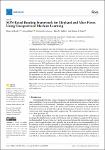SDN-Based Routing Framework for Elephant and Mice Flows Using Unsupervised Machine Learning
| dc.contributor.author | Al-Saadi, M | |
| dc.contributor.author | Khan, Asiya | |
| dc.contributor.author | Kelefouras, V | |
| dc.contributor.author | Walker, DJ | |
| dc.contributor.author | Al-Saadi, B | |
| dc.date.accessioned | 2023-03-20T12:33:33Z | |
| dc.date.available | 2023-03-20T12:33:33Z | |
| dc.date.issued | 2023-03-02 | |
| dc.identifier.issn | 0093-3341 | |
| dc.identifier.issn | 2673-8732 | |
| dc.identifier.uri | https://pearl.plymouth.ac.uk/handle/10026.1/20601 | |
| dc.description.abstract |
<jats:p>Software-defined networks (SDNs) have the capabilities of controlling the efficient movement of data flows through a network to fulfill sufficient flow management and effective usage of network resources. Currently, most data center networks (DCNs) suffer from the exploitation of network resources by large packets (elephant flow) that enter the network at any time, which affects a particular flow (mice flow). Therefore, it is crucial to find a solution for identifying and finding an appropriate routing path in order to improve the network management system. This work proposes a SDN application to find the best path based on the type of flow using network performance metrics. These metrics are used to characterize and identify flows as elephant and mice by utilizing unsupervised machine learning (ML) and the thresholding method. A developed routing algorithm was proposed to select the path based on the type of flow. A validation test was performed by testing the proposed framework using different topologies of the DCN and comparing the performance of a SDN-Ryu controller with that of the proposed framework based on three factors: throughput, bandwidth, and data transfer rate. The results show that 70% of the time, the proposed framework has higher performance for different types of flows.</jats:p> | |
| dc.format.extent | 218-238 | |
| dc.language | en | |
| dc.publisher | MDPI AG | |
| dc.title | SDN-Based Routing Framework for Elephant and Mice Flows Using Unsupervised Machine Learning | |
| dc.type | journal-article | |
| plymouth.issue | 1 | |
| plymouth.volume | 3 | |
| plymouth.publication-status | Published online | |
| plymouth.journal | Network | |
| dc.identifier.doi | 10.3390/network3010011 | |
| plymouth.organisational-group | |Plymouth | |
| plymouth.organisational-group | |Plymouth|Faculty of Science and Engineering | |
| plymouth.organisational-group | |Plymouth|Faculty of Science and Engineering|School of Engineering, Computing and Mathematics | |
| plymouth.organisational-group | |Plymouth|REF 2021 Researchers by UoA | |
| plymouth.organisational-group | |Plymouth|Users by role | |
| plymouth.organisational-group | |Plymouth|Users by role|Academics | |
| plymouth.organisational-group | |Plymouth|REF 2021 Researchers by UoA|UoA12 Engineering | |
| dcterms.dateAccepted | 2023-02-22 | |
| dc.date.updated | 2023-03-20T12:33:32Z | |
| dc.rights.embargodate | 2023-3-24 | |
| dc.identifier.eissn | 2673-8732 | |
| rioxxterms.versionofrecord | 10.3390/network3010011 |


